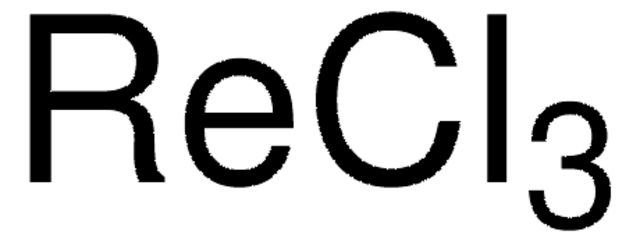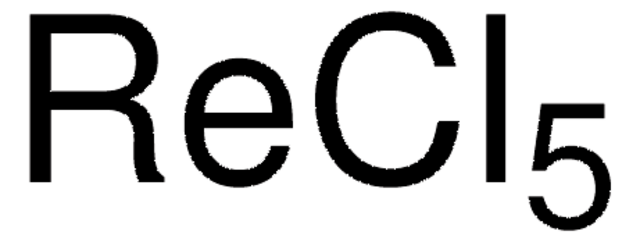380989
Sodium perrhenate
99.99% trace metals basis
Synonym(s):
Sodium Rhenate(VII), Sodium rhenium oxide, Sodiumoxido(trioxo)rhenium
Sign Into View Organizational & Contract Pricing
All Photos(2)
About This Item
Linear Formula:
NaReO4
CAS Number:
Molecular Weight:
273.19
EC Number:
MDL number:
UNSPSC Code:
12352302
PubChem Substance ID:
NACRES:
NA.23
grade:
for analytical purposes
form:
powder or crystals
Recommended Products
grade
for analytical purposes
Assay
99.99% trace metals basis
form
powder or crystals
impurities
≤150.0 ppm Trace Metal Analysis
density
5.39 g/mL at 25 °C (lit.)
SMILES string
[Na+].[O-][Re](=O)(=O)=O
InChI
1S/Na.4O.Re/q+1;;;;-1;
InChI key
KMISVFTVBOPTAI-UHFFFAOYSA-N
Related Categories
Signal Word
Danger
Hazard Statements
Precautionary Statements
Hazard Classifications
Eye Irrit. 2 - Ox. Sol. 2 - Skin Irrit. 2 - STOT SE 3
Target Organs
Respiratory system
Storage Class Code
5.1B - Oxidizing hazardous materials
WGK
WGK 3
Flash Point(F)
Not applicable
Flash Point(C)
Not applicable
Personal Protective Equipment
dust mask type N95 (US), Eyeshields, Gloves
Choose from one of the most recent versions:
Already Own This Product?
Find documentation for the products that you have recently purchased in the Document Library.
Customers Also Viewed
Dien Li et al.
Journal of hazardous materials, 374, 177-185 (2019-04-19)
Technetium-99 (99Tc) is a major contaminant at nuclear power plants and several US Department of Energy sites. Its most common aqueous species, pertechnetate (TcO4-), is very mobile in the environment, and currently there are no effective technologies for its sequestration.
Rui Cao et al.
Inorganic chemistry, 50(19), 9499-9507 (2011-08-30)
We describe a multidentate tripodal ligand in which three pendant arms carrying di(2-picolyl)amine units are linked to the ortho positions of a tris(o-xylyl) scaffold, providing N(CH(2)-o-C(6)H(4)CH(2)N(CH(2)py)(2))(3) (L). Reaction of L with CuCl(2) in the presence of hexafluorophosphate anion afforded blue
Julie Di Bernardo et al.
Analytical biochemistry, 415(1), 32-38 (2011-05-07)
The sodium/iodide symporter (NIS) is primarily responsible for iodide accumulation in the thyroid gland for the synthesis of thyroid hormones; however, it can also transport other lyotropic anions in the thyroid gland and nonthyroid tissues. Some NIS substrates have important
Baikuntha P Aryal et al.
Journal of biological inorganic chemistry : JBIC : a publication of the Society of Biological Inorganic Chemistry, 17(1), 97-106 (2011-08-24)
Radiolabeled biomolecules are routinely used for clinical diagnostics. (99m)Tc is the most commonly used radioactive tracer in radiopharmaceuticals. (188)Re and (186)Re are also commonly used as radioactive tracers in medicine. However, currently available methods for radiolabeling are lengthy and involve
David P Cormode et al.
Dalton transactions (Cambridge, England : 2003), 39(28), 6532-6541 (2010-06-17)
A disulfide functionalized bis-ferrocene urea acyclic receptor and disulfide functionalized mono- and bis-ferrocene amide and urea appended upper rim calix[4]arene receptors were prepared for the fabrication of SAM redox-active anion sensors. 1H NMR and diffusive voltammetric anion recognition investigations revealed
Our team of scientists has experience in all areas of research including Life Science, Material Science, Chemical Synthesis, Chromatography, Analytical and many others.
Contact Technical Service














